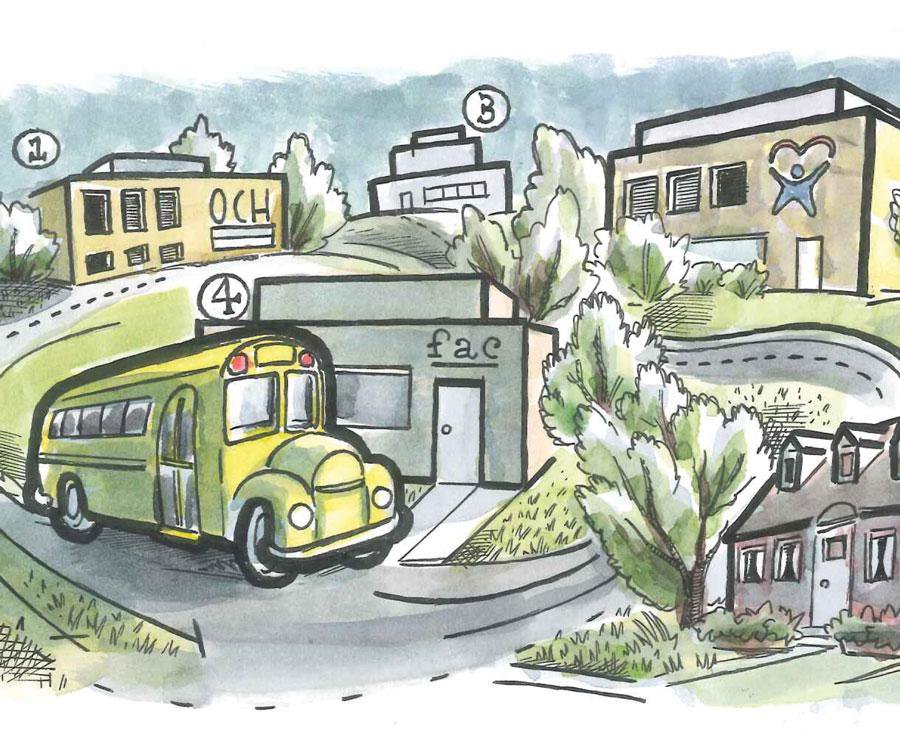
Life
Foster Kid for a Day
Hosted locally in conjunction with Springfield’s Foster Adopt Connect, Missouri’s first-ever Journey Home Bus Tour brings light to the struggle of local kids entering the foster care system.
By Savannah Waszczuk | Illustration by Dusty Campbell
Feb 2016

As I stepped on an old clunky yellow school bus with a group of 25 other 417-landers, I was given a trash bag and asked to close my eyes. Next I was urged to place myself in the shoes of a foster child. I was asked, “If you were given a bag just like this one, and you were told you were leaving your home and not coming back, what would you put in it? You can only take what you can t in the bag.” This situation brought a bit more reality to the Journey Home Bus Tour, a half-day event hosted by Springfield-based Foster Adopt Connect (509 S. Cavalier Ave., Springfield, 417-866-3672, fosteradopt.org) in conjunction with the Foster and Adoptive Care Coalition and the Central Missouri Foster Care and Adoption Association. Similar events were hosted in St. Louis, Kansas City and Jefferson City through Missouri’s foster and adoptive resource centers, with each event hoping to help individuals understand what children in foster care go through.
A handful of 417-landers, including myself, attended Springfield’s half-day simulation and walked through the same steps a child who was just taken into foster care would take. We started at Ozarks Community Hospital (2828 N. National Ave., Springfield, 417-837-4000, ochonline.com), which is often the first place kids go when they come into care. “The hospital opened an once where case-workers can bring children during nighttime hours, so they don’t have to take them downtown to Children’s Division on the square at 2 a.m.,” says Deb Fusek, the organizer of the Journey Home Bus Tour and a volunteer of Foster Adopt Connect. “Sometimes the hospital is the entry point into care. Physicians sometimes take children into custody.” Next we hopped on the bus and headed to the Child Advocacy Center (1033 E. Walnut St., Springfield, 417-831-2327, childadvocacycenter.org). The advocacy center is where children go if they have to be interviewed for a number of things, including sexual abuse. Employees of the Advocacy Center talked guests through the process of interviewing the children. The space is warm and welcoming with kid-friendly murals and a smiling staff, but it’s heartbreaking to know the truths that are discovered within those walls.
The next stop was the Children’s Division (149 Park Central Square, Springfield), where kids have to go and wait, sometimes for many hours, while paperwork is done. The waiting room is stark and plain, and it’s only large enough for a couple of chairs and a small children’s-sized bed. There are rarely many toys here. There is a small TV with a few movies, but it is hardly enough to occupy the kids during the diffcult, confusing time. There is also often a scarcity of clothing and food here, so children are stuck in whatever they had on when they were taken from their homes, which is sometimes pajamas or soiled clothing, and they can’t get much more than a small snack to ll their bellies for what may be 8 or 10 hours.
Next we visited Foster Adopt Connect, where we watched a video about adoption and foster care and heard from a foster mother and an adoptive mom. We also toured Sammy’s Window, which provides clothing, food, hygiene items, school supplies and furnishings to foster and adoptive families. The tour ended with talks from Beth Atchison, the executive director of CASA of Southwest Missouri (Springfield, 417-864-6202, casaswmo.org), and Judge Hosmer. Atchison discussed the experience of being the voice of the child, and Hosmer, who is the decision-maker in these cases in Greene County, discussed the needs of these many children.
While many people aren’t aware of the problem of children going into foster care and not having a family that will care for or adopt them, the numbers speak for themselves. There are currently 820 children in care in Greene County, which is down—the number is usually around 1,000. This is especially high since there are only about 200 foster homes in the county. There is a great need for both foster and adoptive families for children of all ages, because when homes aren’t found, children age out of foster care, and they have the odds stacked against them. The foster cycle continues, but hopefully, with a little help from this experience, we can make a difference.
“The day was really designed to help the participants see what it’s like to be that child, not just talk about them,” Fusek says. “When you’re on the tour, you start to sense that desperation to get to a home and be safe and sound, not just be in limbo. I wanted people to have an experiential feel for how important it is for kids to get to permanency.” Foster Adopt Connect is currently planning another event for fall 2016.











